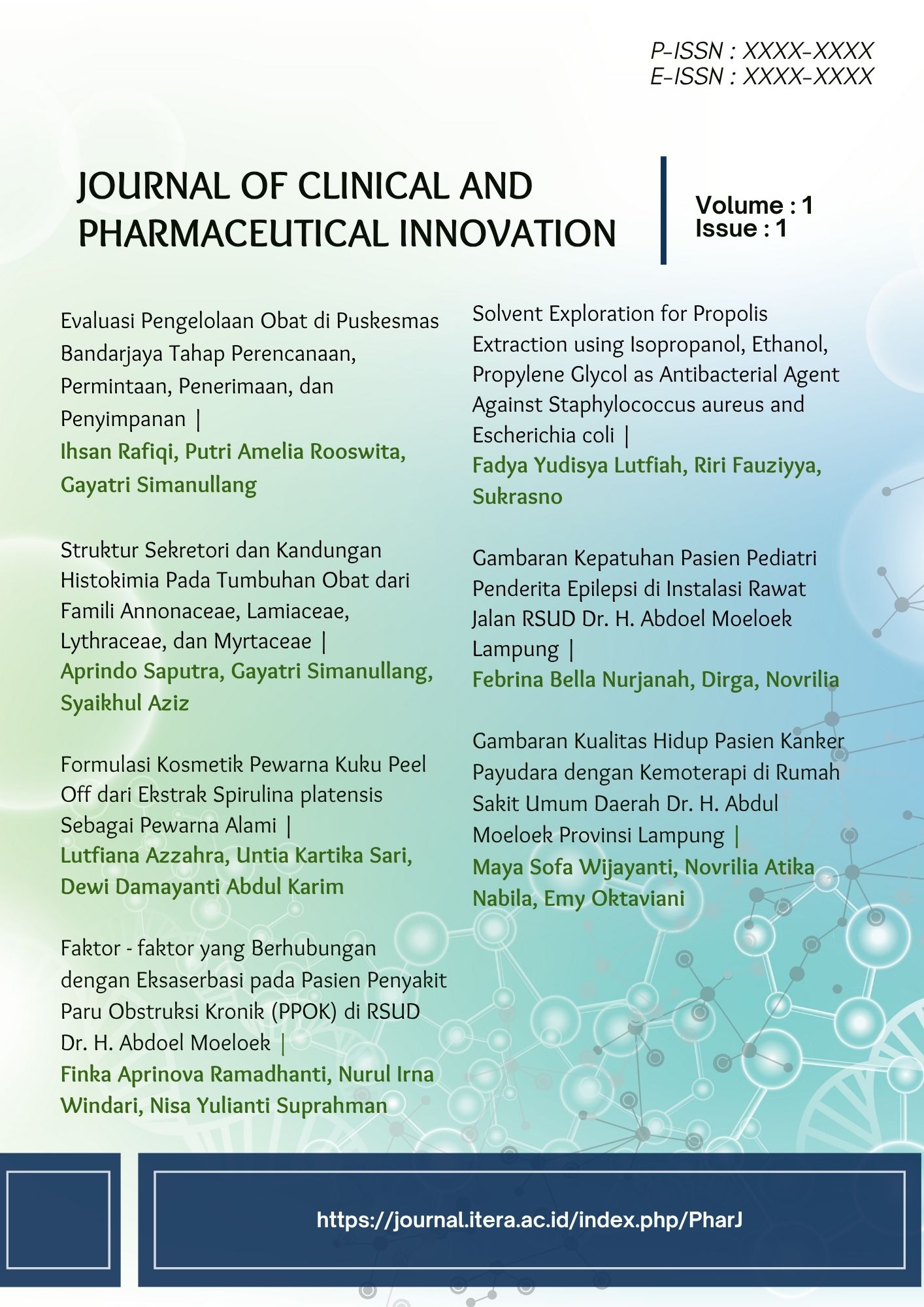Solvent Exploration for Propolis Extraction Using Isopropanol, Ethanol, Propylene Glycol as Antibacterial Agent Against Staphylococcus aureus and Escherichia coli
Abstract
Propolis is one of the bee’s products that is reported has many benefits from its compounds. Propolis has a complex compound, therefore it is important to choose a suitable solvent for the extraction process. The aim of this study was to determine propolis’ solubility, the secondary metabolite classes, and antibacterial activity against S.aureus and E.coli of propolis extracted using different solvents, namely ethanol 96%, isopropanol, propylene glycol, and the combination of three solvents. There were nine ratios of used in the extraction process, A1(Ethanol 96%); A2 (Isopropanol); A3 (Propylene glycol); B1((Ethanol 96%:Isopropanol:Propylene glycol (6:3:1)); B2 ((Ethanol 96%:Isopropanol:Propylene glycol (1:6:3)); B3 (Ethanol 96 %:Isopropanol:Propylene glycol (3:1:6)); C1 ((Isopropanol:Propylene glycol (8:2)); C2 (Ethanol 96%:Propylene glycol (2:8)); dan C3 (Ethanol 96%:Isopropanol (8:2)). The best solubility was determined by the height of the precipitate after centrifugation. The secondary metabolite classes were tested on each extract. Antibacterial activity was tested using the diffusion method. The order of solvents that produced low precipitate was isopropanol, ethanol 96%, and propylene glycol. All propolis extracts were positive alkaloid, saponin, tannin, flavonoid, and negative for steroid/triterpenoid. The result of antibacterial activity against S.aureus in extracts A1, A2, B1, B2, B3, C1, C2, C3 showed weak inhibitory with respective inhibition zones 2,10 ± 0,62; 2,40 ± 0,60; 3,17 ± 0,80; 3,50 ± 0,44; 3,30 ± 0,10; 3,30 ± 1,56; 3,10 ± 0,96; 3,78 ± 0,69. All propolis extracts didn’t present any inhibition zones against E.coli.
Downloads
References
[2] I. Przybyłek, “Antibacterial Properties of Propolis,” J. Rev. Mol., vol. 24, no. 2047, pp. 11–13, 2019.
[3] Y. K. Park and M. Ikegaki, “Preparation of Water and Ethanolic Extract of Propolis and Evaluation of the Preparations.” pp. 2230–2232, 1998.
[4] M. M. Rahman and A. Richardson, “Antibacterial activity of propolis and honey against Staphylococcus aureus and Escherichia coli,” vol. 4, no. 16, pp. 1872–1878, 2010.
[5] R. C. Rowe, P. J. Sheskey, and M. E. Quinn, Handbook Pharmaceutical Excipients, 6th ed. Pharmaceutical Press, 2009.
[6] T. M. Nalawade, K. Bhat, and S. H. P. Sogi, “Bactericidal activity of propylene glycol , glycerine , polyethylene glycol 400 , and polyethylene glycol 1000 against selected microorganisms,” J. Int. Soc. Prev. Community Dent., vol. 5, no. 2, 2015, doi: 10.4103/2231-0762.155736.
[7] A. Şahİner, E. Halat, and E. A. Yapar, “Comparison of bactericidal and fungicidal efficacy of antiseptic formulations according to EN 13727 and EN 13624 standards,” Turkish J. Med. Sci., vol. 49, pp. 1564–1567, 2019, doi: 10.3906/sag-1906-53.
[8] S. P. Baggini, “Sterilization in Microbiology,” Medicon Microbiol., vol. 1, no. 2, pp. 23–29, 2022.
[9] P. Sood, N. Sood, and T. Gokhale, “Microwaves: An Alternative Bacterial Sterilization Technique?,” GSTF J. Biosci., vol. 3, no. 2, pp. 1–5, 2015, doi: 10.5176/2251-3140_3.2.52.
[10] K. Wise, “Preparing Spread Plates Protocols,” Am. Soc. Microbiol. Microbe Libr., no. October, pp. 1–8, 2006.
[11] C. Suplement, Performance Standards for Antimicrobial Suspectibility Testing, 30th ed. USA: Clinical and Laboratory Standards Institute, 2020.
[12] Greenwood, Antibiotics Susceptibility (Sensitivity) Test Antimicrobial and Chemotherapy. USA: Mc Graw-Hll, 1995.
[13] Karmini, Statistika Nonparametrik. Samarinda: Mulawarman University, 2020.
[14] F. R. Wolayan, R. Hadju, and M. R. Imbar, KIMIA ORGANIK. Bandung: Patra Media Grafindo Bandung, 2022.
[15] “Compound Summary : Isopropyl Alcohol,” National Center for Biotechnology Information, 2023. https://pubchem.ncbi.nlm.nih.gov/compound/Isopropyl-Alcohol
[16] “Compound Summary : Ethanol,” National Center for Biotechnology Information, 2023. https://pubchem.ncbi.nlm.nih.gov/compound/Ethanol#section=Uses (accessed May 17, 2023).
[17] “Compound Summary : Propylene Glycol,” National Center for Biotechnology Information, 2023. https://pubchem.ncbi.nlm.nih.gov/compound/Propylene-glycol
[18] M. Oroian, F. Dranca, and F. Ursachi, “Comparative evaluation of maceration , microwave and ultrasonic- assisted extraction of phenolic compounds from propolis,” J. Food Sci. Technol., vol. 57, no. 1, pp. 70–78, 2020, doi: 10.1007/s13197-019-04031-x.
[19] A. H. Mulyati, A. Sulaeman, S. A. Marliyati, M. Radi, and A. M. Fikri, “Phytochemical Analysis and Antioxidant Activities of ethanol extrac of stingless bee propolis from Indonesia,” in AIP Conference Proceedings, 2020, vol. 030014, no. September 2015.
[20] Z. A. A. Sari and R. Febriawan, “Perbedaan hasil uji aktivitas antibakteri metode well diffusion dan kirby bauer terhadap pertumbuhan bakteri,” J. Med. Hutama, vol. 02, no. 04, pp. 1156–1162, 2021.
[21] H. A. Kahraman et al., “Ethanolic extract of Turkish bee pollen and propolis: phenolic composition, antiradical, antiproliferative and antibacterial activities,” Biotechnol. Biotechnol. Equip., vol. 36, no. 1, pp. 44–55, 2022, doi: 10.1080/13102818.2022.2045217.
[22] Jawetz, Melnick, and Adelberg, Mikrobiologi Kedokteran. Jakarta: EGC Penerbit Buku Kedokteran, 2008.
[23] J. Bryan, P. Redden, and C. Traba, “The mechanism of action of Russian propolis ethanol extracts against two antibiotic-resistant biofilm-forming bacteria,” vol. 62, pp. 192–198, 2015, doi: 10.1111/lam.12532.
[24] I. AL-Ani, S. Zimmermann, J. Reichling, and M. Wink, “Antimicrobial Activities of European Propolis Collected from Various Geographic Origins Alone and in Combination with Antibiotics,” Medicines, vol. 5, no. 1, p. 2, 2018, doi: 10.3390/medicines5010002.
[25] M. Wink, “Modes of Action of Herbal Medicines and Plant Secondary Metabolites,” Medicines, vol. 2, no. 3, pp. 251–286, 2015, doi: 10.3390/medicines2030251.
[26] M. Wink, “Evolutionary Advantage and Molecular Modes of Action of Multi-Component Mixtures Used in Phytomedicine,” Curr. Drug Metab., vol. 9, no. 10, pp. 996–1009, 2008, doi: 10.2174/138920008786927794.



